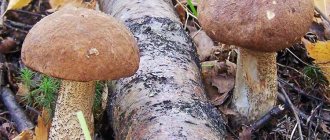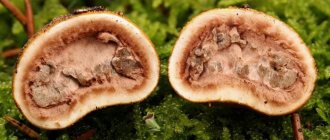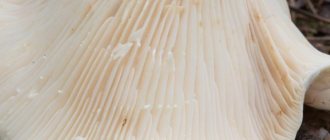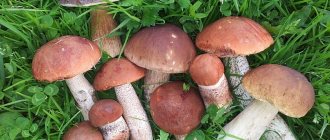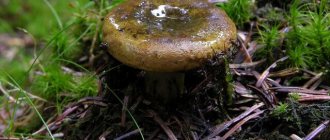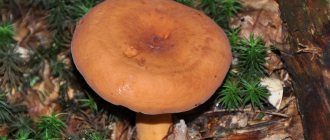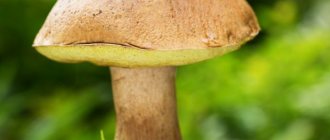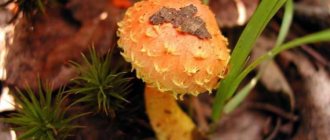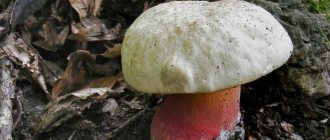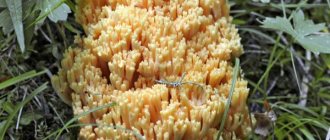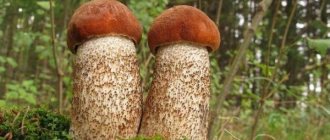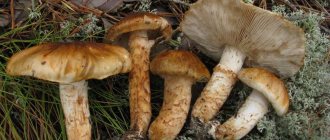Boletus mushrooms are very beautiful in appearance. These aromatic, tasty and satisfying mushrooms are collected in a basket next to plantings of birch, hornbeam and poplar. Mycelium mushrooms grow in damp lowlands and on the edges. From a distance, people notice the portly caps of mushrooms peeking out from under fallen leaves and grass.
The boletus forms a mycorrhizal association with birch trees, as evidenced by the name of the fungus. It is found in Europe, the Himalayas, Asia and other regions of the Northern Hemisphere. Some subspecies have chosen pine or beech forests and the edges of wetlands.
Boletus is a European species. But it has been introduced with ornamental birch trees planted outside their native range, such as in California, New Zealand and Australia.
Father to father - discord
The culinary qualities of the mushroom are impeccable, and it can be found almost throughout Russia in birch or mixed forests from May to October.
The boletus mushroom, or as it is also called, obabok, has several types. All of them are edible, but differ slightly in taste.
Where and when are boletus harvested?
Mushrooms have chosen deciduous forests in the temperate climate zone and choose clearings for mycelium next to birch trees, with which they form mycorrhizae.
Young mushrooms are strong and tight to palpation. They choose open places for growth on the edges, clearings and along paths. The boletus does not like acidified soils near peat bogs; it chooses soil in low-lying forests with a neutral or calcareous substrate. People collect mushrooms from May until the autumn cold and first frosts. One of the subspecies - the marsh boletus - settles on peat bogs near swamps.
Multi-colored boletuses grow in small families or one at a time. Their colorful caps attract mushroom pickers from late June to early October. Mushrooms are cut under birch and poplar trees. Myceliums take root in mossy and gloomy forests, but in open areas under the rays of the sun.
A rare species, the pink boletus settles on peat bogs along the borders of swamps near birch and mixed forests, where it forms mycorrhiza with birch. Mushroom pickers collect mushrooms wherever there are birch plantings, right down to the tundra from the end of July to the end of September.
Gray boletus, also known as hornbeam, produces a rich harvest on the edges and clearings among:
- poplars and birches;
- hazel trees;
- hornbeams and beech trees.
Harvesting:
- when the rowan tree blooms;
- in July after haymaking;
- from late August to October.
Mushroom pickers sometimes find the stiff boletus (rare) in deciduous and deciduous-coniferous plantings near white poplars and aspens. The fungus prefers limestones, where it lives alone or in small families. The rare harvest is harvested from late June to mid-autumn.
In damp lowlands among birches, in pine-birch mixed forests, on the outskirts of clearings and among swamps, from mid-summer until golden autumn, people collect black boletus.
Common boletus
The cap of this mushroom is brown, sometimes with a brown or red tint.
This largely depends on the place where it grows. The leg is juicy, hard with black scales, thickening near the ground.
How to identify false boletus
In conclusion, let’s consider an important question for a novice mushroom picker: how to distinguish a real boletus from its double?
To avoid mistakes, you should remember a few simple rules. Firstly, boletus flowers do not like light. If you see a similar mushroom growing in an open place, this is already a reason for doubt.
Secondly, false boletus usually tastes bitter, so worms do not eat them. Examine the mushroom. If it is perfectly clean, with veins on the legs in the form of blood vessels, then most likely you are holding an inedible mushroom in your hands.
Thirdly, a proven way to determine whether it is a real boletus or not is to break the cap. Here the false mushroom will immediately give itself away, starting to noticeably turn blue. And if after this action the flesh has practically not changed, feel free to put the mushroom in the basket.
Marsh boletus
This type of mushroom grows in very moist soils. Color: light gray or dark yellow.
Unlike an ordinary obedok, its leg is thin. The pulp is fatty and soft. The taste is excellent.
Habitat
The boletus boletus is common in temperate regions of the Northern Hemisphere, more often on the Eurasian continent. It is found everywhere in the CIS. Prefers acidic and moist soils.
Where does boletus grow? The plant forms mycorrhiza (symbiosis with the roots of the plant) with birch, and therefore settles in close proximity to it.
Where to collect boletus boletus? The mushroom can be found in damp, mossy, swampy birch, as well as mixed and deciduous forests, near and in swamps. Usually grows solitary.
Boletus is harsh
The cap of the stiff boletus can be either gray, brown or purple. In old mushrooms it is smooth, but in young specimens it is scaly. The leg is smooth, white with a brown tint near the ground.
The mushroom has a very bright smell, and dishes made from it have a sweet taste. When mechanically applied to fresh pulp, it quickly darkens.
Description and features of the mushroom
Boletaceae belong to the genus Leccinum or boletaceae of the Boletaceae family, which includes, in addition to the boletus boletus itself, also the boletus boletus. Forming mycorrhiza with birch, it is usually found near these trees. A characteristic appearance distinguishes boletus mushrooms from other mushrooms:
- The caps are convex, matte, dry. Diameter up to 15 cm.
- The color of the “head” varies from gray to black. There is a variety of mushroom that has a white cap.
- In young specimens the cap is white below, but with age it acquires a gray-brown tint.
- The stem of the boletus is light, slightly thickened (thickness up to 3 cm). It reaches a height of 15-17 cm. It has longitudinal dark scales.
- The flesh of the mushroom is white and does not change color when broken, with rare exceptions. Young specimens are dense and tender inside; when they grow, the flesh becomes loose.
Chemical composition of boletus
The benefits of boletus are due to the large amount of vitamins, fiber, easily digestible proteins and carbohydrates it contains, which it receives due to interaction with the roots of the tree. The nutritional qualities of the mushroom make it similar to meat. It also contains a complete set of amino acids necessary for humans. And in terms of mineral content, it is comparable to porcini mushroom, only slightly inferior to it.
The mushroom contains vitamins of groups C, PP, E, B1 and B2 and minerals such as:
- potassium - most of all;
- manganese – 37% of the daily value;
- calcium – 18% of the daily value;
- phosphorus;
- sodium;
- magnesium;
- iron.
The dense, fleshy part of the boletus mushroom is a source of coarse dietary fiber. Its value lies in its well-balanced protein.
The nutritional value of boletus is as follows:
- per 100 g of product – about 20 kcal;
- water – 90.1 g;
- fiber – 5.1 g;
- proteins – 2.3 g;
- carbohydrates – 1.2 g;
- fats – 0.9 g.
Boletus pinkish
This species is native to forested areas of northern Russia and is usually found in late summer or fall.
The color of the caps is from burgundy to brown. The legs of the pink boletus are thin and short, bending in the sunny direction.
How to collect
The main harvesting season for boletus boletus begins in July and lasts until October. However, the first specimens may appear in early May. Since the mushroom is not afraid of cold weather, boletus boletus can be found even until frost.
The flesh of the mushroom cap is loose, flabby, and raw. And with age, these properties of boletus boletus increase. Therefore, only young specimens are suitable for collection. Old mushrooms become so wet that it is impossible to bring them home; they turn into a slippery mass.
Found boletus mushrooms are cut with a sharp knife, carefully so as not to damage the mycelium, at a distance of 1.5-2 cm from the ground.
Black boletus
Its name comes from its dark cap, which can even be black. The mushroom has a voluminous but short stalk with dark growths.
This trophy does not often find its way into the basket of mushroom pickers, although it is highly valued by gourmets for its excellent taste.
How to cook
The mushroom is quite tasty, so in cooking boletus boletus is used for boiling, frying, and stewing. If you use young specimens, they retain their density after heat treatment, including after boiling.
The stem of the mushroom is quite hard and fibrous, so there are recommendations to remove it completely and use only the caps for cooking.
As for the preparations, due to the peculiarities of the flesh of the cap, the boletus boletus is not suitable for pickling, since it does not hold its shape at all and simply “spreads” in the marinade. For pickling, use exclusively dry salted boletus boletus recipe.
Grabovik
This variety of boletus can have a cap of different colors: gray, brown white, ash or ocher.
Grows in the southern latitudes of Russia. Most often found in deciduous forests in the Caucasus, especially in hornbeams.
Varieties
Boletus mushrooms can be divided into several varieties depending on their appearance and growing conditions. In total, there are about 40 of them, but not all of them can be found in Russia. The following are the most common types:
- Ordinary is the most common and most valuable from the point of view of the preferences of culinary masters. The cap has a uniform color, the leg at the bottom is thickened.
- White - grows in damp places and is not particularly productive (white boletus).
- Harsh – loves sandy soils and loamy soils of aspens and poplars. The brown cap is pubescent, the flesh turns pink when cut, and the leg below becomes lilac.
- Swampy - quite common in swampy, damp areas. The cap has a lighter shade, the leg is thinner.
- Pinkish - found mainly in autumn in humid northern forests. The color of the cap is uneven, brownish, and the flesh at the break turns pink as a result of oxidation.
- Gray (hornbeam) - has the longest collection period: from spring to autumn. The cap is brown-olive and grayish in color with tubercles and wrinkles, a relatively short stem, the flesh turns purple and then black when cut.
There are also black and multi-colored varieties in nature.
All these mushrooms feel great among birch trees, but they are also found in other trees. More often they grow in places that are well warmed by the sun, but with sufficiently moist soil.
Boletus in a summer cottage
You can grow obabkas yourself if birch trees grow in your summer cottage or next to a fence.
To do this, you need to make an aqueous solution with fungal spores. Carefully removing the turf from the birch roots, water them with this solution. Subsequently, the mycelium must be darkened and periodically moistened.
You will have to wait a long time for the harvest, but one day you will unexpectedly be happy! There are many photos of boletus mushrooms grown at home on social networks.
Self-cultivation of boletus mushrooms
By bringing the mycelium from the forest along with the soil, or using the spore-bearing layer of caps, it is quite possible to breed caps on your site. For a successful process, it is important to remember that the conditions in which you are going to grow mushrooms must be identical to natural ones. Humidity and sunlight are mandatory attributes.
Important! Choose birch trees that are at least 5 years old for breeding sparrows. Otherwise, the tree will not be able to provide the mycelium with all the nutrients.
Not only tasty, but also healthy
Boletus is low in color, but contains a number of microelements necessary for humans.
Eating it has a beneficial effect on the nervous system and normalizes blood sugar levels, which is very important for people suffering from diabetes.
The mushroom is recommended for use in the diet menu; in addition, it removes toxic substances from the body and normalizes kidney function.
Although boletus is not classified as a poisonous mushroom, it can cause an allergic reaction in some people. To avoid poisoning, you should be careful when handling any cooked mushrooms that have been stored for a long time.
Taste qualities of mushrooms
Swamp boletus differs from ordinary boletus in its loose pulp, which boils heavily, turns the broth dark and becomes not only ugly to look at, but also completely tasteless. In addition, it is advisable to take only young white ducks for food. It is recommended to cut only caps that are dry to the touch. Marsh boletus is not collected for preparations, because when salted and pickled, the pulp spreads in the liquid and becomes completely unappetizing. Loose pods have few characteristic aromatic compounds, and therefore young specimens are simply placed together with more valuable ones to increase the mass of the dish.
Warning! Beginning mushroom pickers need to remember that they don’t collect old white mushrooms, because they fall apart on the way home, and the loose pulp becomes unattractive.
Useful tips
It’s best to take a wicker basket or a food-grade plastic bucket with you to the forest to pick mushrooms.
It is not recommended to collect it in a plastic bag or canvas bag; you will bring home dented, broken and unsightly-looking forest trophies. It is better not to take mushrooms that you found in some place that is not typical for their growth.
It’s good if you take a camera with you into the forest. After all, posting a photo of boletus mushrooms on your social network page and boasting about a successful trip to the forest to your friends is always a pleasure!
If you have doubts about whether a mushroom is edible, do not risk it and leave it in the forest. Processing of the mushroom “catch” must be started without delay, upon returning home.
Boletus of any kind is suitable for preparing a variety of dishes - stewing, frying, drying or pickling. It makes an excellent mushroom soup.
Freezing works well: taking a bag of mushrooms out of the freezer in winter, you will prepare a fragrant and tasty dish that will remind you of summer!
How to distinguish edible from inedible
Boletus and boletus, edible mushrooms, can most often be confused with an inedible mushroom called gall or false porcini mushroom. These mushrooms are very similar to each other, and the external differences between them are very insignificant.
If you are not sure what boletus mushrooms look like, a photo and description should always be at hand. To distinguish boletus from gall mushroom, lightly press the cap from below. With the slightest pressure, the flesh of the gall mushroom turns pink, and the flesh of boletus can only darken.
